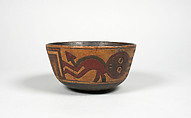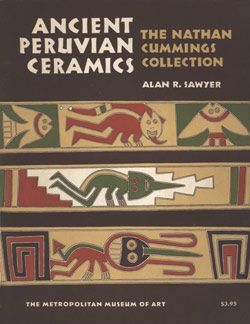Bowl
Not on view
This polychrome bowl depicts two anthropomorphic figures on their sides, alternating with a rectangular shape. Created using low-relief incised lines, an emblematic decorative technique of Paracas society, the individual is depicted on its side, suggesting that it is flying. The figures are identical, with round heads, eyes, fangs, and two insect-like antennas extending from their head. They have two legs, two arms, claws, and a tail; the use of different colors emphasizes these features. Between the two figures are incised concentric rectangles that fill the height of the wall, also highlighted through use of colored paint and incising.
Pattern, color, and radiance were highly esteemed visual qualities in the Paracas culture and people exerted great effort to acquire the materials necessary for making ceramic objects. This vessel would have been created using the coil, paddle and anvil technique. It was made using a reduction-fire kiln that produced smudged black and gray surfaces, visible on the interior walls of the bowl. After the vessel was fired, lively yellow, red, and gray, were applied. This technique made the vessel quite fragile; however, it also enabled vibrant colors to significant effect.
The Paracas culture flourished in the southern coast of Peru between 700 B.C. and 1 A.D. during an era in which technical and artistic ingenuity was celebrated. Their innovative and complex pictorial tradition is evidenced in their ceramics, as well as their textiles—two traditions that often shared an iconographic vocabulary. Color was a pivotal component to the cultural production of Paracas works and the sophistication of its use and production is still visible today through examples that maintain their lively hues. Although pottery production in the Andes could have occurred year-round, it was probably a seasonal activity that accounted for the time necessary to gather source materials for fabrication. For instance, the acquisition of certain colorants would have meant local or long-distance exchanges and clay would only have been retrieved from riverbanks during the period of seasonal floods. Moreover, the manufacturing of ceramics was a costly endeavor that required expert knowledge to properly prepare the clay, as well as colored pigments, which were made using specific formulas that incorporated binders to help the paint adhere to ceramic surfaces.
Paracas is well known for its large cemeteries and elaborately decorated mummy bundles that consisted of layers of sumptuous textiles, in addition to feathered costumes, gold jewelry, food and ceramic vessels. In some cases examples of color pigments were also included with the dead—a practice that signified its reverence and importance within the culture.
Christina De León, Ph.D. student, Bard Graduate Center, 2017
References
DeLeonardis, Lisa. “Encoded Process, Embodied Meaning in Paracas Post-fired Ceramics” in Making Value, Making Meaning: Techné in the Pre-Columbian World, edited by Cathy Lynne Costin, pp. 129-166. Washington, D.C.: Dumbarton Oaks Research Library and Collection, 2016.
Stone, Rebecca R. Art of the Andes: From Chavín to Inca, Third edition. London: Thames & Hudson, 2012.
Due to rights restrictions, this image cannot be enlarged, viewed at full screen, or downloaded.


